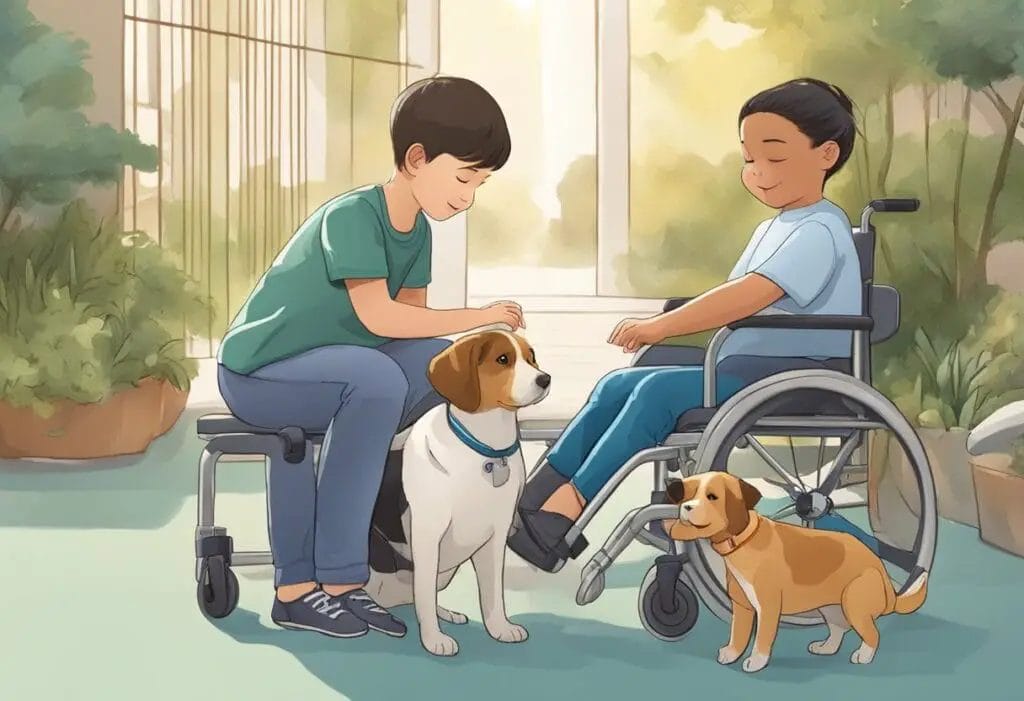Dogs are known for their ability to provide comfort and reduce stress, which is especially important for children with disabilities who may experience higher levels of anxiety and stress.

Service dogs are trained to perform specific tasks to assist individuals with disabilities, while therapeutic dogs are trained to provide emotional support and companionship.
Therapy dogs can help children with disabilities in a variety of ways, including reducing anxiety and depression, improving social skills, and increasing physical activity.
Children with disabilities may face unique challenges in their daily lives, and therapeutic dogs can provide a source of comfort and stability. These dogs can help children feel more confident and independent, while also providing a sense of security. With the right training and support, therapeutic dogs can be valuable companions for children with disabilities.
Understanding Therapy Dogs
Therapy dogs are one such companion that can help children with disabilities to feel more at ease and comfortable in their environment. In this section, I will discuss the role of therapy dogs and the certification and training they require.
The Role of Therapy Dogs
Therapy dogs are pets that have been trained to provide comfort and support to individuals with disabilities. These dogs can help children with disabilities to feel more relaxed and at ease in difficult situations. They can also help to reduce stress and anxiety, increase social interaction, and improve overall well-being.
Therapy dogs can be used in a variety of settings, including hospitals, nursing homes, schools, and rehabilitation centers. They can help children with disabilities to feel more comfortable during medical procedures, provide emotional support during therapy sessions, and assist with physical therapy exercises.
Certification and Training
To become a therapy dog, a dog must be certified by a recognized therapy dog organization. These organizations evaluate dogs based on their temperament, obedience, and social skills. Once a dog has been certified, they can begin working as a therapy dog.
Therapy dogs require specialized training to learn how to interact with individuals with disabilities. This training includes learning how to remain calm and gentle in stressful situations, how to respond to commands, and how to interact with individuals with disabilities in a safe and appropriate manner.
As an owner of a therapy dog, it is important to ensure that your dog is properly trained and certified. This will ensure that your dog is able to provide the best possible support to individuals with disabilities.
Therapy Dogs and Children with Disabilities
Therapy dogs are specially trained to provide comfort, emotional support, and companionship to individuals with various needs. In this section, I will discuss how therapy dogs can benefit children with disabilities, including those with autism spectrum disorder, ADHD, and other developmental disabilities.
Therapy Dogs in Schools
Therapy dogs are becoming increasingly popular in schools as a way to help children with disabilities. They can be used to help reduce anxiety, improve social skills, and provide emotional support. Therapy dogs can also help children with learning difficulties by providing a calming presence during class and helping them to focus on their work.
In addition, therapy dogs can be used to help children with behavioral disorders. For example, they can help to reduce aggression and improve verbal communication skills. They can also help children with special needs to feel more included in the classroom and improve their overall sense of well-being.
Benefits for Children with Autism Spectrum Disorder
Therapy dogs can be particularly beneficial for children with autism spectrum disorder (ASD). They can help to improve social skills, reduce anxiety, and provide emotional support. In addition, therapy dogs can be used to help children with ASD to develop better communication skills. For example, they can be used to encourage verbal communication and improve nonverbal communication skills.
Research has shown that therapy dogs can also help children with ASD to improve their behavior. For example, they can help to reduce repetitive behaviors and improve overall attention span. Therapy dogs can also help children with ASD to feel more comfortable in social situations and improve their ability to interact with others.
Therapy Dogs and ADHD
Therapy dogs can also be beneficial for children with ADHD. They can help to reduce hyperactivity and improve overall focus. In addition, therapy dogs can be used to help children with ADHD to develop better social skills. For example, they can be used to encourage positive interactions with others and improve communication skills.
Research has shown that therapy dogs can also help children with ADHD to improve their behavior. For example, they can help to reduce impulsive behavior and improve overall attention span. Therapy dogs can also help children with ADHD to feel more relaxed and calm, which can improve their overall sense of well-being.
The Science Behind Animal-Assisted Therapy

It is a complementary medicine intervention that utilizes dogs trained to be obedient, calm, and comforting. The presence of a therapy dog can help children with disabilities feel more relaxed and safe, and can even provide emotional support.
Physical and Emotional Benefits
Studies have shown that animal-assisted therapy can have a positive impact on a child’s physical health. For example, it can help lower blood pressure and cortisol levels, which are associated with stress. Additionally, it can improve cardiovascular health, reduce pain, and even boost the immune system.
But animal-assisted therapy isn’t just good for physical health. It can also provide emotional benefits. For example, it can reduce anxiety, depression, and feelings of loneliness. It can also increase feelings of happiness and well-being.
Improving Cognitive Function and Focus
Animal-assisted therapy can also help improve cognitive function and focus. For example, it can enhance problem-solving skills and improve memory. Additionally, it can increase focus and attention span, which can be especially helpful for children with ADHD or other attention disorders.
Research has shown that animal-assisted therapy can increase the levels of oxytocin in the brain, which is a hormone that is associated with social bonding and trust. This can help children with disabilities feel more connected to their therapist, which can lead to better therapeutic outcomes.
The Impact of Therapy Dogs on Quality of Life

As a social worker, I have seen firsthand the positive impact therapy dogs can have on children with disabilities. These dogs are specially trained to provide comfort and support to those in need, and they can help reduce stress, promote relaxation, and boost self-confidence.
One of the main responsibilities of therapy dogs is to provide companionship and reduce loneliness. Children with disabilities may feel isolated or excluded from social activities, but having a therapy dog by their side can help them feel more connected to others. These dogs are trained to interact with people in a friendly and non-threatening way, which can help children feel more at ease in social situations.
Animal-assisted therapy (AAT) has been shown to improve the quality of life for children with disabilities. Studies have found that AAT can reduce stress, promote relaxation, and improve overall well-being. For example, one study found that children who interacted with therapy dogs had lower levels of cortisol, a hormone associated with stress.
Therapy dogs can also help promote self-confidence in children with disabilities. These dogs are trained to perform specific tasks, such as retrieving objects or opening doors, which can help children feel more independent. Additionally, therapy dogs are non-judgmental and provide unconditional love and support, which can help boost self-esteem.
Therapy dogs can have a significant impact on the quality of life for children with disabilities. These dogs provide companionship, reduce stress, promote relaxation, boost self-confidence, and improve overall well-being.
